Learn
Soil
Soil Evidence
Soil includes dirt, debris, sediment, sand, and gravel. To the untrained eye, it may all just look like "dirt", but soils can vary greatly, even within a small area. Soil contains unique properties that can be used to determine if soil from a questioned sample could have come from a known source.
Questioned soil samples may be found on evidence such as:
- shoes, tires, or digging tools,
- recovered from a body under the fingernails, or
- even in the nasal cavity, stomach, or lungs of a reburied body.
While soil samples may be very unique, they represent class evidence and must be used alongside other pieces of evidence to connect a suspect to a victim or crime scene.
Soil Collection
To perform a comparison, both questioned and known soil samples must be carefully collected, packaged, and labeled prior to being sent to the lab for analysis.
Watch to see how soil samples are collected and packaged.
- Watch from 0:00 to 0:15 and then watch from 0:28 until 4:53
- Skip ahead to 7:05 and watch until 8:23
Open Collection of Forensic Soil Evidence in a new tab
Knowledge Check #1
From the video, why should breathable packaging be reinforced when packaging soil evidence?
- It may break.
- Soil may escape through the cracks.
Answer: b. Soil may escape through the cracks.
Knowledge Check #2
From the video, reference soils collected from crime scene or alibi locations are known as ________blank.
- questioned samples
- known samples
Answer: b. known samples
Knowledge Check #3
From the video, when collecting soil samples from a digging site, soil samples should be collected _______blank.
- from the deepest layer only
- from each layer to create a sample mixture
- from each layer and packaged separately
Answer: c. from each layer and packaged separately
Questioned Samples
Questioned samples may be adhering to evidence such as a shoe, tire, or tool. In that case, it is best to submit the soil along with the evidence to the lab, without removing the soil.
Questioned soil samples may also be found in areas where it must be removed to transmit it to the lab, such as the floorboard, upholstery, or wheel well of a car. In that case, tools such as tweezers, dental picks, or ice scrapers may be used to collect as much of the sample as possible.

It is important to preserve the layering of dried soil as it can give information as to the order in which the soil was picked up and can provide a timeline of events.

Soil can vary greatly with both distance and depth. Therefore, a variety of known soil samples must be collected. Unless there was digging involved, most soil evidence is surface evidence. Therefore, most known samples should be collected from the surface of the soil in the area surrounding the crime scene. Known samples may also be collected from alibi (where the suspect claimed to be during the time of the crime) locations for comparison.
When collecting known samples, at least three tablespoons of soil should be collected from each area where the suspect is believed to have been. Samples should also be collected from various locations around the crime scene so that the lab can determine how much variation there is in the soil in that area.
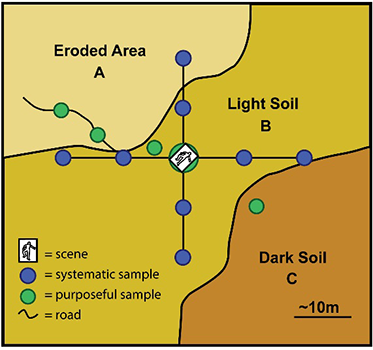
If excavation (digging) was involved, soil samples should also be taken from various depths and packaged separately. The location and depth from which the soil was taken are included on the label and evidence log. A sketch of the scene with labeled depths and photographs will accompany this evidence.
This schematic shows potential soil samples that could be collected around the site of a clandestine, or secret, grave site. Note the samples are taken from various depths up to the deepest point of the grave.
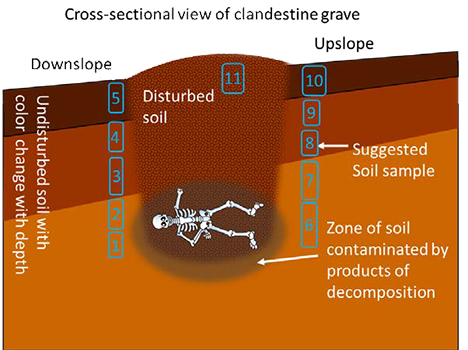
All soil samples should be allowed to air dry prior to final sealing to prevent mold formation. This is typically done by bringing the collected samples to a clean location, opening them, and allowing them to air dry before resealing and transporting to the lab. Alternatives to air drying are refrigerating or freezing the soil samples.
Soil Analysis
Once they arrive at the lab, soil samples are analyzed using both simple techniques and sophisticated instruments.
Scientists begin by using simple techniques to identify properties of the soil, beginning with the general appearance and texture. Scientists may use various light sources, as well as microscopes.
They may all use a sieve to separate the soil into various sized particles for further comparison.

Color
Red, brown, yellow, yellowish-red, grayish-brown, and pale red are all good descriptive colors of soil, but not very exact. Just as paint stores have pages of color chips, soil scientists use a book of color chips that follow the Munsell System of Color Notation. The Munsell System of Color Notation allows for direct comparison of soils anywhere in the world.
The system has three components that are arranged in books of color chips:
- Hue - a specific color
- Value - lightness and darkness
- Chroma -color intensity
Soil is held next to the chips to find a visual match and assigned the corresponding Munsell notation. For example, a brown soil may be noted as: hue value/chroma (10YR 5/3) . Color can be used as a clue to mineral content of a soil (USDA).
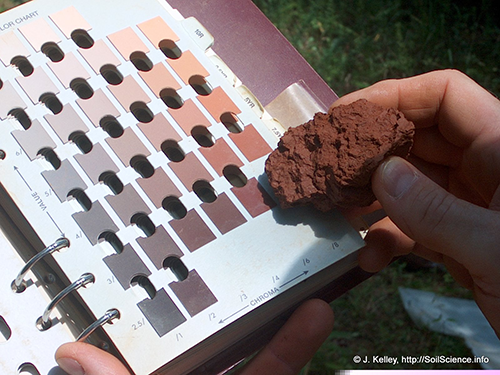
Texture
Soil may be made of sand, silt, or clay in a variety of compositions. These terms are used to classify the particles within the soil based on their size, with sand being courser and larger than silt or clay.
- Clay: a fine-grained material with a diameter less than 0.002 mm; soft and flexible when wet but hard when dry
- Sand: a loose granular material (particle size 0.05mm - 2.0 mm) derived from the disintegration of rocks
- Silt: fine soil particles between the size of sand and clay (roughly 0.05mm-.002mm) which are deposited as sediment
A soil textural triangle allows for the classification of the soil based on the percentage of each of these within it.

Much of the surface soil in Alabama is sandy loam, which has a high percentage of silt and sand with a low percentage of clay, while subsurface soils contain more clay.
How to Use the Triangle
We have a sample that is 40% clay, 50% silt, and 10% sand.
- Beginning with clay, we would find 40% and make a diagonal line on the triangle.
- Next, we would find silt, which is on the right-hand side, and trace the diagonal line for 50%.
- Finally, we would find 10% for sand along the bottom and trace that diagonal line.
- The point at which these three lines intersect reveals the type of soil. In this case, our soil sample falls right between silty clay and silty clay loam.
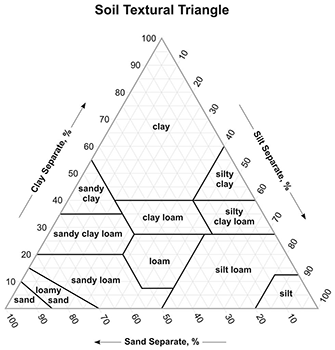
Knowledge Check #4
What type of soil is composed of 20% clay, 30% silt and 50% sand?
- sandy clay
- silty clay
- loam
- loamy sand
Answer: c. loam
pH
The make-up of the soil, as well as the drainage conditions in the area, will affect the acidity of the soil. The presence of lime Calcium oxide or CaO , for example, will make a soil more basic. Alternately, the presence of sulfates or nitrates will make a soil more acidic. Acidity is measured using the pH scale and a universal indicator, which changes colors to indicate the pH.
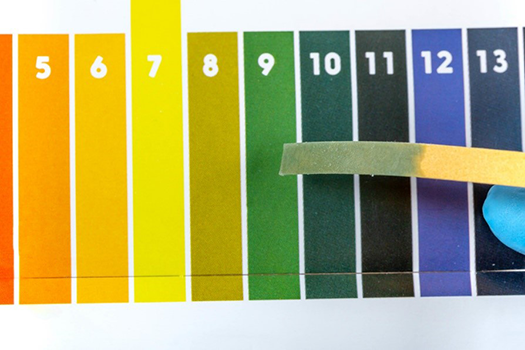
A pH of less than 7 indicates an acidic soil, while a soil sample with pH above 7 is basic or alkaline. Neutral soils will have a pH of 7.
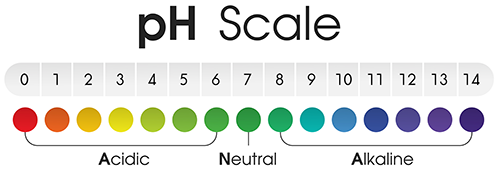
Knowledge Check #5
Soil is placed in a vial with a bit of water and shaken. The pH of the resulting liquid is measured and found to be 8.2. Is the soil acidic, basic, or neutral?
- acidic
- basic
- neutral
Answer: b. basic
Sophisticated Technology
If a known and questioned sample align in color, pH, and composition, further tests may be used to determine the elemental composition of the soil. One of the most common tests used for soil analysis is X-ray diffraction (XRD), a non-destructive test that uses x-rays to determine the crystalline structure of a material. The sample will scatter the x-rays in unique patterns which can be studied to identify fine-grained materials such as clays that are difficult to determine optically. The XRD patterns of a known and questioned sample can be compared to further support or refute a visual match.
Take a look at this example of an x-ray diffraction comparison of a sample from the suspect's car (a) and a local quarry (b). The similarities indicate that these two samples are likely derived from the same location.
Credits
"Standard Guide for Collection of Soils and Other Geological Evidence for Criminal Forensic Applications - Draft Document" (January 2020) by the Organization of Scientific Area Committees (OSAC) for Forensic Science, National Institute of Standards and Technology (NIST), U.S. Department of Commerce. https://www.nist.gov/system/files/documents/2020/01/16/Standard%20Guide%20for%20the%20Collection%20of%20Soils%20and%20Other%20Geological%20Evidence_190627_DraftforWebsite2.pdf
"The Color of Soil." Natural Resources Conservation Service - Soils, USDA, www.nrcs.usda.gov/wps/portal/nrcs/detail/soils/edu/?cid=nrcs142p2_054286.